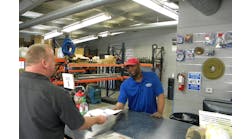The interesting thing about diversification is that it can be both a game-changer and a gamble. And like consolidation, it can be an industry's response to either good times or bad. When diversification is widely adopted by an industry in other markets, but not in the United States, you have to wonder whether the wind will blow this way.
In construction industries outside of North America, particularly the civil engineering sector, it is common for large players to integrate equipment rental operations into a group structure. For these companies, the specific advantages of adding rental may outweigh any arguments against diversification.
Several studies in the United Kingdom have suggested that construction firms perform better if they are focused, rather than broadly diversified. When diversification stays close to home, however, there appears to be a value in integrating closely aligned businesses such as aggregates, window fabrication and equipment rental (called plant hire in the U.K.). A construction company with its own rental fleet can control the availability, quality and cost of its equipment, while generating external revenue.
In general, large overseas contractors and civil engineering firms have taken one of three approaches to fleet: rely on equipment rental suppliers for most equipment needs; purchase a range of fleet that is utilized internally by its divisions as well as externally (to varying degrees) by customers; or adopt a market-facing model that offers rental as an extension of its expertise. The two latter strategies make a company more vulnerable to a downturn, but potentially more competitive in an upturn.
A 10-year trend toward outsourcing in the U.K. has moderately tempered the number of construction and engineering firms that offer rental. However, plenty of prominent examples remain, including Balfour Beatty, Laing O'Rourke, Kier Group, Walters Group and The Mabey Group of Companies.
The investments are not incidental: Select Plant, the equipment rental arm of £4.1 billion (about U.S. $6.1 billion) private contractor Laing O'Rourke, claims the U.K,'s only contractor-owned fleet of rubber-tired mobile cranes for hire. And the Mabey Group is looking to increase its rental coverage through acquisitions and cold starts, as evidenced by the recent opening of a new rental depot in Scotland.
Kier Group plc is an example of a multi-national building and civil engineering group that views diversification as a competitive advantage. The company promotes its “rare offering of in-house capability, coupled with our strategic alliance business units” to its markets in the U.K., the Middle East, the Caribbean and Eastern Europe.
Kier Plant, the six-depot rental business of Kier Group, is a staple of the company's British business interests. About 50 percent of Kier Plant's rentals come from within the group, with the balance being generated externally. Kier Plant managing director Ian Gordon has publicly affirmed the parent company's commitment to equipment rental.
In 2009, Kier Plant accounted for about £27 million (U.S. $40.2 million) of the group's £2.1 billion (U.S. $3.1 billion) revenues, but its profit contribution historically has been more significant than its top-line percentage. For its six-month interim results for the period ended Dec. 31, Kier reported a 4.4-percent operating margin for its Support Services business, of which rental is one of four non-construction units. By contrast, Kier's construction business margin was 2.5 percent.
Kier's incoming chief executive, Paul Sheffield, reinforced the attractiveness of rental in a recent interview with RER, saying, “It's a higher margin business than construction and it's an area for growth, as there will be more pressure put on local authorities to reduce their budgets. One of the ways to do that is to outsource. We believe that there will be more contracts coming out to allow us to expand that side of the business.”
By contrast, the Mabey Group of Companies uses equipment rental as a pure-play diversification strategy. British-based Mabey Group is a global engineering group with roots in construction manufacture, specializing in bridging, steel fabrication and construction products. Its U.K. rental business, which operates as Mabey Hire Services, differs from some models in that the fleet is deployed solely on the open market. Performance is measured separately from the rest of the Group, with metrics focusing on individual product categories and end markets.
Mark Rooney has served as chief operating officer of Mabey Hire Services since 2009, after joining the business a year earlier as operations director. He took the helm at a time of transition for the Group's rental services: Mabey Hire Services was formed this past October through an internal merger of two rental business units — Mabey Hire and Murrayplant — and one engineering and site support unit, Mabey Support Systems.
The result is a 17-depot rental operation that also functions as a specialist manufacturer of ground support, formwork, refurbishment and other systems — part of what the company describes as the largest range of non-mechanical plant available for rent in Great Britain.
The merger, says Rooney, “was purely strategic. We had two or three complementary businesses that had been formed over the years to suit specific needs. Essentially we were doing similar things in slightly different markets, and we felt that if we joined those businesses together we would have a broader appeal to customers. The merger also has given us a more extensive depot network with better coverage around the country.”
In addition to market presence, Mabey Hire Service's combined operations have allowed the company to rent to more types of customers more efficiently, Rooney says. “The components of the fleet have remained the same, but our depots have access to a wider range of construction equipment for different applications, as does our sales team.”
Currently, the largest component of the fleet involves shoring and trench boxes for groundwork — the sector served previously by Murrayplant and Mabey Hire. “I think that we will stay in a relatively similar fleet position for now, but we want to re-target the market and gain ground,” Rooney says. “We feel that the new structure has put us in a much stronger position to grow our market share.”
While acknowledging that, “the market has been difficult for the last 12 to 18 months,” Rooney says that Mabey Hire Services is fighting aggressively for the work that is out there. “Rental revenues currently account for about 15 per-cent of the Group's total revenues [£177 million in 2009 (U.S. $263.7 million], he says. “We would expect to see that number increase slightly as the economy recovers and markets expand.”
Rooney says the company is also using this time to partner with customers, “to make sure we're bringing products to market that clearly satisfy their needs. Rather than perform the trials ourselves, we are working with customers to have them trial the equipment and provide feedback. Customers are a very important part of any investment we make.”
Because Mabey Hire Services rents a somewhat specialized fleet solely to external customers, the model avoids the question of how deeply a company should invest in general construction equipment for its own use. If Mabey needs equipment on a temporary basis, “we try to get it from around the group of companies first whenever possible,” Rooney says. “But if it isn't available internally, then it would be rented from other hire companies.”
Some companies have tried for a middle ground crafted around specialization. In 2000, civil engineering firm Birse sold most of its Birse Plant Hire fleet to Ashtead, parent of U.S.-based Sunbelt Rentals. But Birse chose to retain its crawler cranes and piling rigs, both for its own use and for external rentals.
A year later, Birse announced that it would transform its crane rental fleet into solely hydraulic machines in response to market demand. In 2006, the company was acquired by civil engineering and construction giant Balfour Beatty, which has extensive rental operations of its own.
For some companies with heavy investments in fleet, divestiture makes sense. Two years ago, AMEC PLC made the decision to sell its in-house tool and equipment rental business Logistics & Support Services Limited (LSS) to U.K. rental company Speedy Hire for £12.5 million (U.S. $18.6 million) in cash. AMEC also guaranteed Speedy £30 million (U.S. $44.7 million) of annual contract revenue for four years. The deal made Speedy a major supplier to the rail and industrial sectors.
The sale fit AMEC's strategic decision to sell off its non-core businesses and concentrate on providing consultancy, engineering and project management services. In commenting on the deal, AMEC chief executive Samir Brikho described Speedy as, “a strong purchaser [that] wants to develop and invest further in these operations. It is a good outcome for the business.”
Steve Corcoran, chief executive of Speedy Hire, points to the synergies of the LSS acquisition, which involved 10 depots and 250 employees. “The embedded skill sets acquired with LSS of planned and preventive maintenance, long-term contract support and shutdown coordination complement Speedy's existing expertise in these areas. When combined with the asset support of the wider Speedy group, these have created market-leading propositions.”
Corcoran adds, “The benefits to clients like AMEC are that it enables them to drive for operational efficiency and excellence, while at the same time ensures that key areas like health and safety compliance, environment, sustainability and quality assurance are upheld.”
Mabey Hire Services uses its standalone model to trade on a similar basis of outsourcing. Mark Rooney notes that, “The value of what we offer is that our equipment range represents only a small part of our customers' needs, but it is the kind of equipment that would be difficult for them to own and maintain. We provide them with equipment they couldn't or wouldn't want to look after themselves.”
How does competition factor into the saturated U.K. rental market? Sub-renting can be a tactic, Rooney says, although, “very much case by case. We call it cross-hire; we would cross-hire to other rental companies if it was the right thing to do from a business standpoint.”
With rental rates under pressure and credit hard to come by in most markets around the globe, the environment has hardly been ideal for a foray into rental. As the cycle turns, however, the strategic value of vertical integration will again come under scrutiny by related industries.
Integration in the U.S.?
There are toes in the water in North America, but relatively few — and those that do exist tend to be specialized. For example, Mabey Bridge & Shore has operated in the U.S. for about 20 years as a leading East Coast source for the rental of temporary and prefabricated bridges, overground and underground shoring, and temporary roadways.
Balfour Beatty operates a market-facing rental business for general construction equipment, but not in the United States. Balfour Beatty Plant & Fleet Services is an internal/external model that provides the U.K. with cranes, trackside equipment, general construction equipment and company vehicles. Rentals are made to the Group's companies, as well as to a number of strategic external customers. In the U.S., Balfour Beatty Rail rents specialty equipment, as it does in the U.K.
Fluor Corp., one of the world's largest engineering, procurement, construction and project management companies, has built a reputation for assisting customers across every phase of a project. The company's Global Services business includes Greenville, S.C.-based AMECO, a jobsite supplier that prides itself on its breadth of services, including tool, equipment and vehicle rental.
AMECO's rental operations have benefited from outsourcing, although its revenue footprint has changed. In 2003, about 80 percent of AMECO's revenue was tied to U.S. projects managed by Fluor; by mid-2009, 80 percent was outside the United States and largely non-Fluor. The shift gained steam in international markets where rental is a readily sought, high-profile solution — a trend that purchase-prone U.S. contractors have been slower to adopt.
Will the U.S. follow the integration trend? If the next few years were going to be business as usual for the equipment rental industry, there would be little reason to speculate on integration from outside. But the recession has changed things in terms of equipment supply, market mentality and the potential for acquisition. There are opportunities inherent in all three areas, and foreign interests may well take note.
It is true that some contractors may balk at sourcing their equipment through a competitor-owned rental company — particularly with preferred supplier arrangements. And yes, the pros and cons of vertical integration have to be carefully weighed.
But the construction landscape is moving toward consolidation and internationalization, with fewer and larger operators. Investors are increasingly looking to European companies and evaluating overseas business models. If diversification into equipment rental can give a company a low-cost competitive advantage, it will be on the radar.
The recession has made U.S. contractors more aware of the economic benefits of renting and left some rental players in need of financial support. At the very least, the timing is interesting. If The Wall Street Journal is correct that businesses in general are becoming more prone to “go vertical,” we may be at the leading edge of a departure from a 50-year trend toward specialization.
That doesn't mean that the average contractor will add rental services. But it could mean that large construction and engineering firms with proven rental models in other markets will look for synergies in North America.
Lucy Peterson is the president and owner of Balboni Associates Inc. and its press distribution division, IndustryWire. The company is a longstanding U.S. supplier of market communication and consultancy services to rental and related industries. She can be reached at [email protected].





